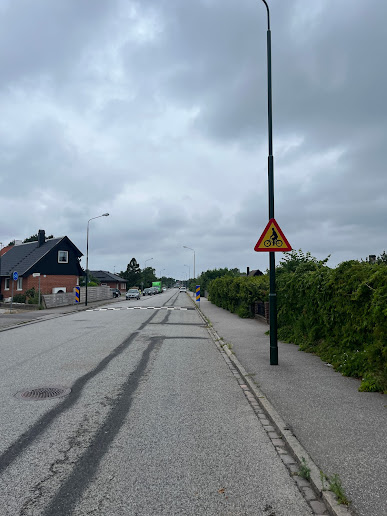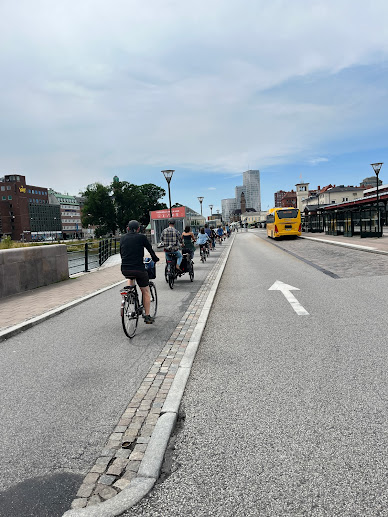For the weekend our group made a brief visit to Malmö, Sweden before we head off to the Netherlands. While many used it as a weekend of rest (between big cities), I still made it out a considerable amount and would like to share my impressions about the city as a whole. I also want to note that our entire time here it was overcast and rainy (which, honestly for me was a little nice to get a break from the heat. The weather reminded me of springtime in Oregon).
First of all, the train ride over was extremely easy. We all gathered at Copenhagen Central Station and hopped on a very clean and modern train that would take us the Øresund, into Malmö. Even though this is technically an 'international' tain, being in the EU makes the whole process so much easier. Other than a quick crew change at Hyllie - the first stop in Sweden - (and unless you have a trained eye you wouldn't even notice this) we were in Malmö in no time.
 |
| The train to Malmö |
After getting our bags dropped off at the hostel, we had some time to kill before we picked up our bikes. I opted in walking around for a bit. I quickly noticed some of the streets here resemble what is the fate of most US cities. Some roads seemed to have no bike lanes, no painted lanes, just not 'welcoming' for bikes. To be perfectly honest, at first, I was a little intimidated to be biking in the city. That is not to say the bike infrastructure is bad, because it isn't.
However, we quickly ended up walking down a pedestrian/bike walkway that was closed to cars. (we also discovered that some things here are ridiculously cheap, which was a pleasant surprise after paying a lot for goods in Denmark). We found a cool little street fair near the train station and had a nice lunch before picking up the bikes.
As we picked up our bikes, two folks from the city accompanied us on a brief tour of the city by bike! A couple of things I learned from that:
- BIKE THEFT is a thing, it happens in Malmö. Both the people from the city and the rental place mentioned it. (and we were given some cable locks as an extra precaution). This is the first time I have heard an 'official' figure mention the topic (!!). However, most people still do not lock their bikes to anything...
- Malmö central train station has a pretty nice facility for bikes.
- All bike lanes are bi-directional (more on this in a moment)
- Roughly 25.5% of people commute by bike, with a goal of 30% by 2030.
- Accessibility for mobility impaired seems better here
- About 10% of people wear bike helmets here, and they might become mandatory at some point
Two-way bike lanes
Once we got going on the bike I started to pick up the bike infrastructure. The extreme difference between Denmark (where we just were) and Sweden is that the latter is all about bi-directional bikeways. If a road has a bikeway, it's always bi-directional.
I have to say, I have some mixed feelings about this setup. On one hand, I actually like the bikeways because they are significantly wider (also, they are at the same level as the sidewalks, which means that bikes can easily veer into the sidewalks if needed). This may not seem major at first, however, after spending some time riding these bikeways, I came to like this factor. Why? Say, for example, you want to ride alongside your friend. In Denmark, the bike lanes are only 'wide enough' for 2 bikes to be side to side. This means that one is kinda forced to ride single-file in order to get passed by other bikers on the road. However in Malmö, because the bike lanes are easily wide enough for 3 bikes, it is very easy to ride alongside someone, with room to the left of you to allow for passing bikes or cross traffic when needed!
The downsides:
- They are only on one side of the street
- Intersections can get complicated/narrow
- They become less practical as capacity increases (which is not necessarily what you want when planning a high-capacity bike network)
 |
| One of the busier intersections, where a two-way bike lane meets another two-way bike lane |
All in all, I will say that with the riding that I did in Malmö, the two-way bike lanes are actually better than I thought they would be. However, I am also curious to see what the city would look like if they instead decided to install a mix of regular and bi-directional bike lanes.
BTW, for those in the audience who are unfamiliar with biking, two-way bike lanes like this are in certain places in the US. For example, the very popular
13th Avenue bikeway in Eugene uses bi-directional bikeways. Unlike Malmö, however, the bike lane is at the same level as the street, not the sidewalk.
All in all, it's an interesting trade-off, and I think I like Denmark's set up a little better (just because it is more practical), but considering how far the US is behind and how much they need to get caught up, I could see either approach working for us at home in the near term.
Bike to the castle
On Saturday a small group of us decided to bike to a local castle that was roughly 10 miles away from our hostel. While it was still very overcast (with intermittent showers) we eventually caught a break and decided to go for it. While there were about 10 of us total biking there, we quickly broke the group up into 3 based on our speed. We were lucky to have much nicer bikes in Malmö, with 7-speed gears instead of 3-speed. These bikes allowed us to comfortably go much faster.
Most of the ride to the castle was on dedicated bike paths, although there were some parts where we were on residential 2-way roads. There were no 2-way bike lanes here, and we had to share the road with cars. It reminded me a lot of the recreational bike trails in Oregon, except I noticed these seemed to have little to no at-grade road crossings.
 |
| Biking to the castle |
For a brief section by the end of our ride, we had to bike down a 'high speed' road with no bike lane. (luckily on the way back we discovered there is a road with a bike lane nearby). This seemed very scary at first, but I quickly discovered it is nothing like biking down these kinda roads in the US. Cars slowed down to a crawl to pass us and would give us plenty of room.
After going up the final hill, we arrived at the castle in one piece. The
castle itself was pretty cool, we got lunch and walked around a bit. While a group opted to take a combination of bike and train back to the hostel, a few of us decided to just bike all the way back. Luckily I had remembered the route there (for the most part) so the ride back felt easier. (We also got back just before the rain came down!)
 |
| Shared road/bike lane |
I also biked around a bit to get dinner etc. before returning my bike. I'm not sure if it was because of the weather, but I definitely noticed fewer people on bikes.
Other things about Malmö
On our last day in Malmö, we didn't have any bikes, so I rode around on public transit for a bit.
Buses
There are lots of green buses roaming around the city. They were very easy to board. For most of them, you could just tap onboard with Apple Pay or a contactless credit card. This makes it very easy for newcomers to ride without having to figure out how to buy a transit pass, etc.
 |
An 80-foot, triple articulated Malmö city bus.
(Photo courtesy of Marc Schlossberg)
|
A few of the BRT routes (
Malmöexpressen as they call it) use 80-foot-long double-articulated buses. They do not have buses that long back at home! All the buses I rode were relatively modern, frequent, and reliable.
 |
| Interior of the buses, with clear signage indicating stops (and even arrival times for transferring to other buses) |
Trains
I also had a few hours to take the 90-minute train ride to the
Järnvägens Museum. The train ride there was relatively easy. My only confusion is on where to sit once you're onboard. Evidently, there are certain cars/seats where people can reserve seats, but it is not clearly marked which seats are available and which seats aren't. Twice I had people tell me I was sitting in their seat. The train had high-speed wifi which is something you won't see in the US.
The train museum itself was relatively interesting. The layout of this museum was a little better than the other museums I visited thus far. However, most of the writing was in Swedish (thank you Google Translate!). The inside of it seemed 'modern' and updated, but there were lots of historical articles as well. On the way back, I had to sit in the vestibule area between cars because the train was so full.
Western Harbor
On our last night in Malmö, our professor led us on a brief walking tour of the
Western Harbor. This has to be one of the coolest medium to high-density housing developments I have ever seen. Not only is it right along the water, but every building also looks significantly different. The insides had great quiet communal space, with lots of greenery intertwined. This might have been the most unique thing about my visit to Malmö.
In conclusion
Other than the weather, I am glad we had the opportunity to come and visit and bike around Sweden. It was definitely a smaller town, in fact probably around the same size as Eugene OR(?).. and with that, it felt like a quieter place. Fewer people on the streets, businesses closed earlier, etc. It was a good excuse to catch up on some blogs and recharge, but now I'm definitely ready to head back to the big city - Amsterdam - in the Netherlands!











I really like your writing and the details/descriptions of your various excursions and the modes/infrastructure that supported the,. I'm also appreciating that you are up for exploring all the places we visit and not afraid to figure out each new transit system. And I'm glad you liked Western Harbor as well!
ReplyDelete